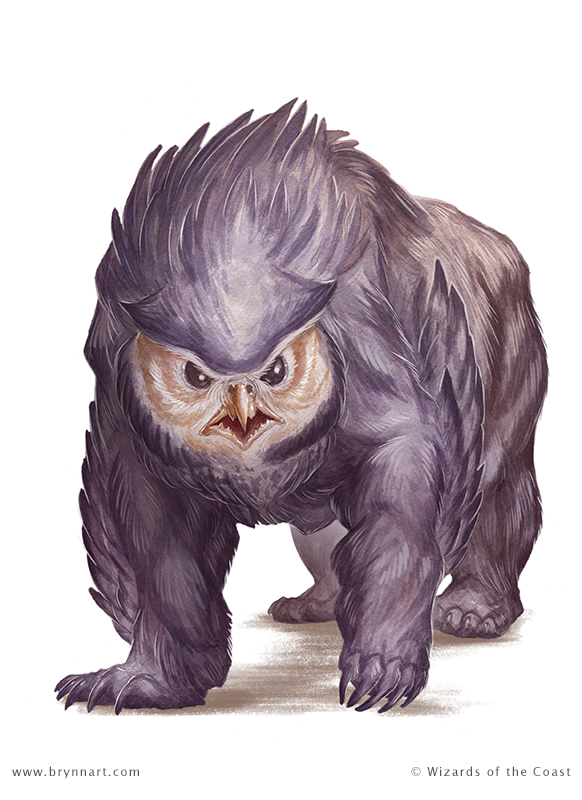 |
| Statblock and illustration from the AD&D Monster Manual |
From the AD&D2e Monstrous Manual description of the owlbear (basically the same as the AD&D1e Monster Manual version):
"The owlbear attacks prey on sight, always fighting to the death (ignore morale rating for purposes of determining retreat). It attacks with its claws and snapping beak. If an owlbear scores a claw hit with a roll of 18 or better, it drags its victim into a hug, subsequently squeezing its opponent for 2-16 points of damage per round until either the victim or the owlbear is slain. The owlbear can also use its beak attack on victims caught in its grasp, but cannot use its claws. A single attempt at a bend bars/lift gates roll may be made to break from the grasp of an owlbear. Note that if the Armor Class of a victim is high enough that 18 is insufficient to hit, the hug is not effective and no damage is taken."
One of the things that used to make owlbears terrifying to low-ish level characters back in the day, besides their psychotic rage and refusal to run, was this potential for damage escalation. Getting hit by a claw would sting, but if your luck really ran sour you suddenly went from taking maybe 6 or 7 points a round from claw hits to anything up to 28 points a round as it crushed and pecked you to bloody tatters while you struggled helplessly to get away. And like a Terminator robot, it would never stop.
D&D3e sort of kept this, though it shoehorned it into its terrible grappling combat system, a system awful enough to make grown DMs shudder and go weak at the knees. If it managed to grab you, it would (probably) keep doing damage each round, and I guess it could still peck at you, but working out just how much damage it was doing wasn't spelled out — the DM had to work it out from the grappling rules. Bleeuch.
The rot was clearly setting in.

D&D4e dropped the hugging damage entirely, and just said that if the beast hit with both claws it could bite its victim as well. There was no ongoing round-to-round effect. Booooooring.
In common with most 4e monster descriptions, there's practically no information about it except combat stats, but such description as there is drops any suggestion of congenital insanity for a vicious temper.
Now we come to D&D5e, and things are not getting any better.
Apart from anything else, I think this may be my least favourite artistic rendition of the owlbear. It doesn't look fearsome or crazy or ferocious, it just looks rather stupid and sedentary. Regrettably, the illustration pretty much matches the D&D5e treatment of what used to be an iconic D&D monster.
It's no longer a magically-blended abomination, it's basically just another forest beast. It's no longer fundamentally insane, it's just a bit bad-tempered. It even suggests that it can be
tamed and kept as a pet, for fuck sake. It no longer gets its old signature crushing hug attack at all, it just gets to attack once with its claws and once with its beak each round.
Ho-hum. Ho-bloody-hum.
Basically, what we have here is a long slow slide from what was once a basic but reasonably imaginative creation, to a bear with a funny head.
It's tragic, and it's a crime.
Just as a matter of interest, I intend to re-write the 5e version of the owlbear and take it back to its bizarre, huggy, crushy, psychotic roots.
 |
Here's the original plastic toy the owlbear was imagined from,
along with the rest of the set. |





















